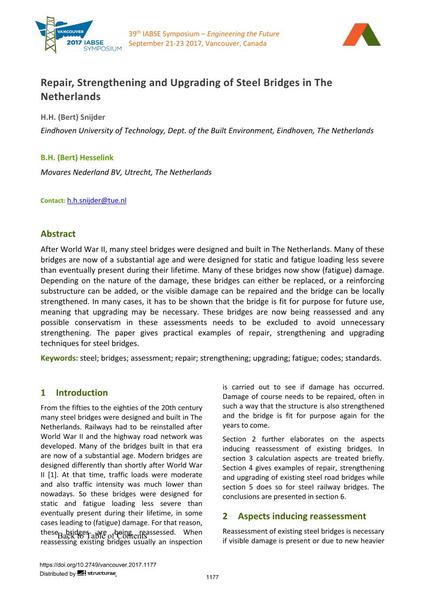Repair, Strengthening and Upgrading of Steel Bridges in The Netherlands

|
|
|||||||||||
Bibliographic Details
| Author(s): |
H. H. (Bert) Snijder
(Eindhoven University of Technology, Dept. of the Built Environment, Eindhoven, The Netherlands)
B. H. (Bert) Hesselink (Movares Nederland BV, Utrecht, The Netherlands) |
||||
|---|---|---|---|---|---|
| Medium: | conference paper | ||||
| Language(s): | English | ||||
| Conference: | IABSE Symposium: Engineering the Future, Vancouver, Canada, 21-23 September 2017 | ||||
| Published in: | IABSE Symposium Vancouver 2017 | ||||
|
|||||
| Page(s): | 1177-1184 | ||||
| Total no. of pages: | 8 | ||||
| Year: | 2017 | ||||
| DOI: | 10.2749/vancouver.2017.1177 | ||||
| Abstract: |
After World War II, many steel bridges were designed and built in The Netherlands. Many of these bridges are now of a substantial age and were designed for static and fatigue loading less severe than eventually present during their lifetime. Many of these bridges now show (fatigue) damage. Depending on the nature of the damage, these bridges can either be replaced, or a reinforcing substructure can be added, or the visible damage can be repaired and the bridge can be locally strengthened. In many cases, it has to be shown that the bridge is fit for purpose for future use, meaning that upgrading may be necessary. These bridges are now being reassessed and any possible conservatism in these assessments needs to be excluded to avoid unnecessary strengthening. The paper gives practical examples of repair, strengthening and upgrading techniques for steel bridges. |
||||
| Keywords: |
steel bridges fatigue standards strengthening repair codes assessment upgrading
|
||||
